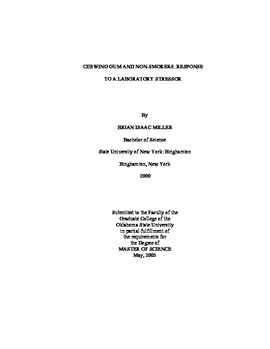| dc.description.abstract | Several studies have suggested that chewing gum can assist individuals to manage symptoms associated with nicotine withdrawal. Likewise, recent work in our laboratory has indicated that chewing gum may aid dependent smokers in recovery from a laboratory stressor. Collectively, this research suggests that chewing gum may function by reducing overall stress levels associated with removal of nicotine from the body, and at least for smokers, it helps reduce laboratory stress. Despite research in the use of chewing gum for reducing nicotine withdrawal and stress levels in smokers, there is little data in regards to the potential benefits of chewing gum for reducing stress in nonsmokers. In a hallmark study conducted in 1939, Hollingworth proposed that chewing gum is a means for individuals to work off nervous energy and thus implicitly suggested chewing gum reduces stress. Since then, there have been no empirical studies evaluating the role of chewing gum as a stress management technique. The goal of the present study was to fill this gap. The present study was designed to extend previous research by examining nonsmokers and by using a non-chewing oral control (breath strips) that share flavor properties of gum without chewing. Participants were assigned to three conditions: Chewing Gum, Breath Strip (Chewing Control), and Non-oral Control. A total of 58 participants were studied (18 in both the Gum and Control groups, and 22 in the Breath Strip group). The experimental procedure was identical to a previous study conducted in our laboratory which indicated that chewing gum was helpful in the recovery from acute stress. Participants were exposed to a public speaking task followed by a 30 minute recovery period. Measures of subjective stress were obtained using the State-Trait Anxiety Inventory and the Emotion Assessment Scale. Analyses indicated that the public speaking task was successful in significantly increasing levels of negative emotions for all participants irrespective of group assignment. Post-stressor, significant reductions in anxiety were observed; however, these reductions also occurred irrespective of group. Overall, the results of the present study found that regular gum chewers do not utilize chewing gum to regulate negative emotions. | |
